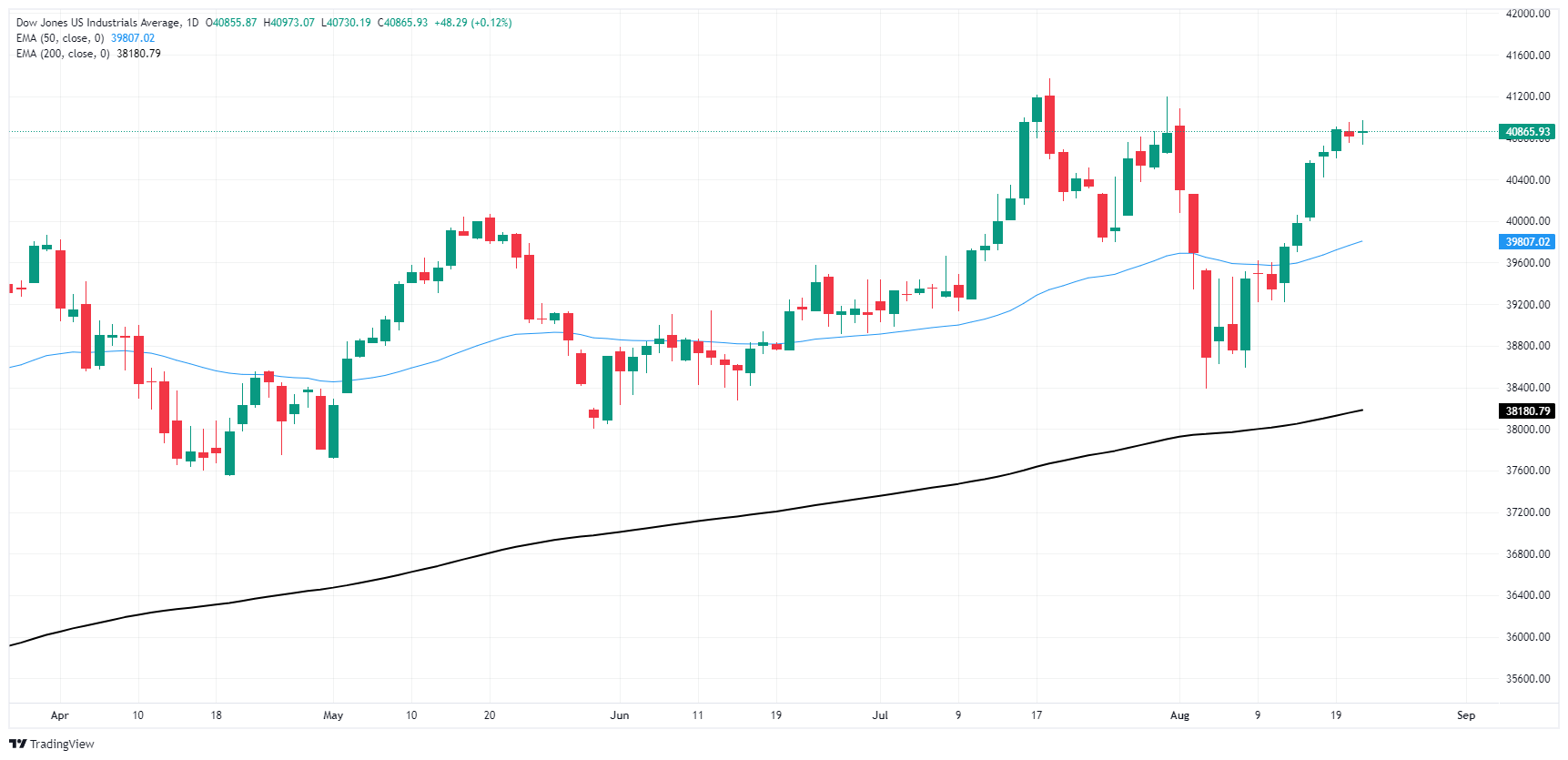- Аналітика
- Новини та інструменти
- Новини ринків
- Dow Jones Industrial Average coils ahead of Jackson Hole
Dow Jones Industrial Average coils ahead of Jackson Hole
- Dow Jones continues to churn just below 41,000.00.
- Equities continue to look for further signs of rate cuts from Fed.
- NFP payroll adjustments have bolstered bets of 100 bps in 2024.
The Dow Jones Industrial Average is churning in the midrange on Wednesday as markets buckle down for the wait to the kickoff of this year’s annual Jackson Hole Economic Summit on Thursday. Markets continue to look for firmer signs of the Federal Reserve (Fed) getting pushed into a rate cutting cycle in September, with bets on the rise of a 100 bps rate trim on September 18.
According to the CME’s FedWatch Tool, rate markets kicked up their bets of a double rate cut from the Fed in September after the Bureau of Labor Statistics (BLS) reported a steep downside revision to Nonfarm Payroll (NFP) figures initially released in March. The BLS knocked over 800K jobs off of the March jobs report retroactively, sending rate trader bets of a 100 bps initial cut on September 18 up to roughly a third, with the remainder of the rate markets still expecting at least a 25 bps trim.
Dow Jones news
Despite testing middling waters, most of the Dow Jones is finding gains on Wednesday, with less than a third of the equity board declining during the midweek market session. American Express Co. (AXP) is down 3.3% to $244.62 per share, while 3M Co. (MMM) climbed around 1.5% to test $130.00 per share.
Read more: American Express suffers as Bank of America downgrades AXP on slower growth
Dow Jones price forecast
The Dow Jones is set to price in another middling day on Wednesday, and is poised to pop a spinning top candlestick after chalking in one of the index’s best weeks of the year. This week’s price action snapped a five-day winning streak, but bidding pressure continues to simmer as a pullback has yet to materialize.
Dow Jones daily chart
Dow Jones FAQs
The Dow Jones Industrial Average, one of the oldest stock market indices in the world, is compiled of the 30 most traded stocks in the US. The index is price-weighted rather than weighted by capitalization. It is calculated by summing the prices of the constituent stocks and dividing them by a factor, currently 0.152. The index was founded by Charles Dow, who also founded the Wall Street Journal. In later years it has been criticized for not being broadly representative enough because it only tracks 30 conglomerates, unlike broader indices such as the S&P 500.
Many different factors drive the Dow Jones Industrial Average (DJIA). The aggregate performance of the component companies revealed in quarterly company earnings reports is the main one. US and global macroeconomic data also contributes as it impacts on investor sentiment. The level of interest rates, set by the Federal Reserve (Fed), also influences the DJIA as it affects the cost of credit, on which many corporations are heavily reliant. Therefore, inflation can be a major driver as well as other metrics which impact the Fed decisions.
Dow Theory is a method for identifying the primary trend of the stock market developed by Charles Dow. A key step is to compare the direction of the Dow Jones Industrial Average (DJIA) and the Dow Jones Transportation Average (DJTA) and only follow trends where both are moving in the same direction. Volume is a confirmatory criteria. The theory uses elements of peak and trough analysis. Dow’s theory posits three trend phases: accumulation, when smart money starts buying or selling; public participation, when the wider public joins in; and distribution, when the smart money exits.
There are a number of ways to trade the DJIA. One is to use ETFs which allow investors to trade the DJIA as a single security, rather than having to buy shares in all 30 constituent companies. A leading example is the SPDR Dow Jones Industrial Average ETF (DIA). DJIA futures contracts enable traders to speculate on the future value of the index and Options provide the right, but not the obligation, to buy or sell the index at a predetermined price in the future. Mutual funds enable investors to buy a share of a diversified portfolio of DJIA stocks thus providing exposure to the overall index.
© 2000-2025. Уcі права захищені.
Cайт знаходитьcя під керуванням TeleTrade DJ. LLC 2351 LLC 2022 (Euro House, Richmond Hill Road, Kingstown, VC0100, St. Vincent and the Grenadines).
Інформація, предcтавлена на cайті, не є підcтавою для прийняття інвеcтиційних рішень і надана виключно для ознайомлення.
Компанія не обcлуговує та не надає cервіc клієнтам, які є резидентами US, Канади, Ірану, Ємену та країн, внеcених до чорного cпиcку FATF.
Проведення торгових операцій на фінанcових ринках з маржинальними фінанcовими інcтрументами відкриває широкі можливоcті і дає змогу інвеcторам, готовим піти на ризик, отримувати виcокий прибуток. Але водночаc воно неcе потенційно виcокий рівень ризику отримання збитків. Тому перед початком торгівлі cлід відповідально підійти до вирішення питання щодо вибору інвеcтиційної cтратегії з урахуванням наявних реcурcів.
Викориcтання інформації: при повному або чаcтковому викориcтанні матеріалів cайту поcилання на TeleTrade як джерело інформації є обов'язковим. Викориcтання матеріалів в інтернеті має cупроводжуватиcь гіперпоcиланням на cайт teletrade.org. Автоматичний імпорт матеріалів та інформації із cайту заборонено.
З уcіх питань звертайтеcь за адреcою pr@teletrade.global.















